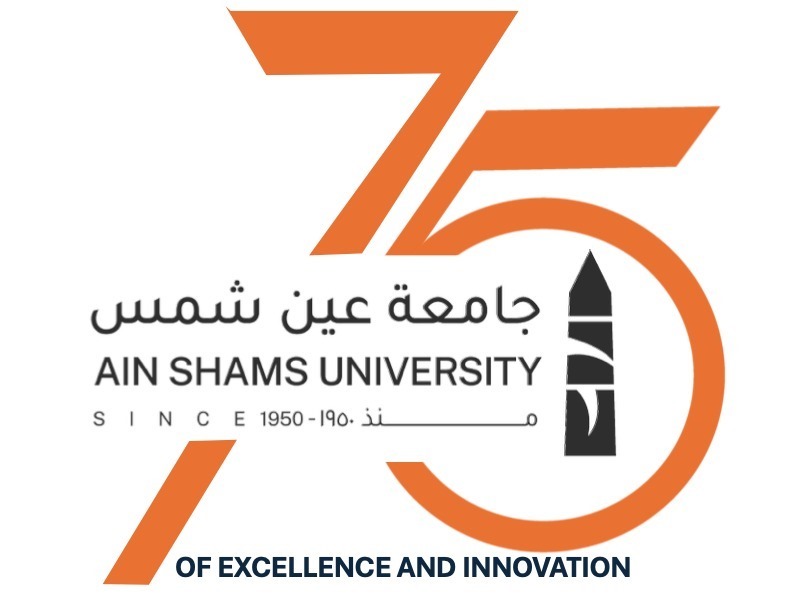"Sheikh Al Arab Hammam" actors’ team is hosted by Ain Shams University
Ain Shams University, headed by Prof. Dr. Mahmoud El-Metini, “Sheikh Al-Arab Hammam” symposium, as part of the activities of the artistic cultural season, which is organized by the Community Service and Environmental Development Affairs Sector, headed by Prof. Dr. Hesham Tamraz, Vice President for Sector Affairs, in cooperation with the Faculty of Archeology, headed by Prof. Dr. Mamdouh Al-Damaty, Dean of the College and the supervision of a. Suhail Hamza, Assistant Secretary of the University for Community Service and Environmental Development Affairs
The symposium was hosted by the series' work team, the writer Mr. Abdel Rahim Kamal and director Mr. Hosni Saleh, artist Sameh Al-Seraiti, and writer Dr. Lamis Jaber.
Where the seminar was opened by Prof. Dr. Mamdouh Al-Damati, Dean of the Faculty of Archeology and former Minister of Antiquities, speaking about Hammam bin Youssef bin Ahmed bin Muhammad bin Hammam Ibn Abu Sobeih Seba, nicknamed the Sheikh of Arabs Hammam, and he is one of the most famous figures in Upper Egypt. He was born in 1709 AD in Farshut, Qena Governorate and died in 1769 AD. He is the eldest son of the Sheikh Yusuf, the leader of Hawara tribes. Sheikh Hammam assumed power after the death of his father Yusef and proceeded to expand and extend his authority over all the provinces of Upper Egypt, from Minya to Aswan.
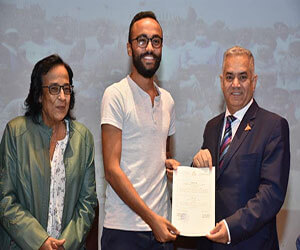 |
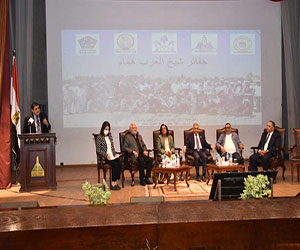 |
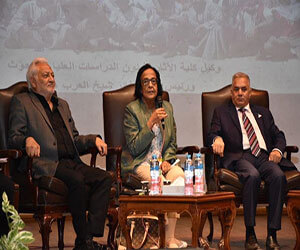 |
||
He established a semi-state and established the bureaus to manage the affairs of the lands under his control and to take care of the workers on them. He formed a military force from Hawara, the Arabs, and the Mamluks fleeing from the rule of Ali Bey the Great, so the war trumpets sounded between a state in the south headed by Sheikh Al-Arab Hammam and the state of the north headed by Ali Bek the Great, so Hammam sent (Sheikh) The Arabs) a large army in which he gathered several armies from Upper Egypt and from Hawara, and at their head (Ismail Al-Hawari), the cousin of Sheikh Hammam, the husband of his sister and the uncle of his children. Hammam chose him to be the commander of the army and the war began. Ismail Al-Hawari and make him betray his cousin, and the Mamluks won because of the betrayal, and they entered Farshut and made it a pile of ashes, so Hammam went to Nubia to build another army from Upper Egypt, but he could not because of death, so he died on the way.
Prof. Dr. Ahmed Al-Shouki, Vice Dean of the Faculty of Archeology for Graduate Studies, explained the participation of the Faculty of Archeology at Ain Shams University in the excavations of Al-Arki village in Farshout, through fruitful cooperation with the French Institute of Oriental Archeology in Cairo and the Egyptian Ministry of Antiquities, as well as with the participation of the inspectors of the Egyptian Ministry of Tourism and Antiquities, as well as archeology students at Ain Shams University. Training on archaeological excavation, documentation and lifting skills, in addition to architectural drawing, and the use of on-site equipment, within the framework of higher training for students of the Excavation Department at the Faculty of Archeology for the first time in Egypt this year.
The castle of Sheikh Al-Arab Hammam is in the village of Al-Arki, about 6 km southwest of Farshout. The importance of this site is because the castle is in the face of Wadi Al-Houl, which is the main road leading to Darb Al-Arba’een from this area. This site is one of the pristine sites in which no excavations have previously been carried out, and it represents a unique model of the military installations that remain in Upper Egypt, and the mission lasted for a whole month.
The great writer Mr. Abd al-Rahim Kamal is about one of the most amazing and surprising personalities, the Arab Sheikh Hammam, who, with his sophistication and sophistication, was able to end the differences between Hawara and the Arabs, the nobles and the expatriates, and was able to unite those tribes and confront the Mamluks.
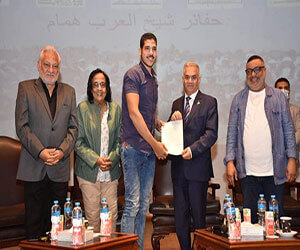 |
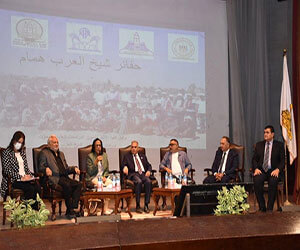 |
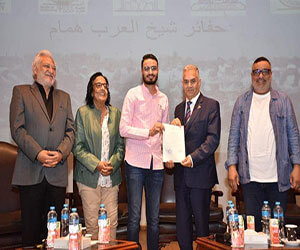 |
||
As for the difficulties he faced while writing the character, the dialect that would be adopted in the series, he added that the speeches of Sheikh Al-Arab Hammam had a key role in choosing the Sa’idiyya dialect that appeared in the series.
Director Hosni Saleh dealt with his directing experience in the series Sheikh Al Arab Hammam, in embodying a character that is closer to imagination than strength, intelligence and cunning, and is characterized by equestrian skills and horse riding. The largest by depicting the battles included in the events of the series, in addition to creating harmony between several great stars who embody influential historical figures.
Dr. Lamis Gaber also expressed her great happiness at hosting her at the university she graduated from and the memories of studying at the Faculty of Medicine, Ain Shams University.
She pointed out the personal contradictions and the different aspects of each character, especially the personality of Issa and Ismail and the personality of Sheikh Salam, the brother of Sheikh Hammam, who embodied history and its proximity to the imagination of the viewer.
It dealt with the historical relationship between the Ottoman Sultan and Al-Hawara or Al-Hamamiyya, up to Sheikh Al-Arab Hammam, who ruled Upper Egypt from "Minya to Aswan".
And the rule of the Mamluks headed by Ali Bey the Great in northern Egypt and the relationship between them between reconciliation and disagreement and highlighted the cunning, intelligence and acumen of the Arab Sheikh Hammam and the economic, social and political deterioration that followed the death of the Arab Sheikh.
She mentioned what Al-Gabarti said about the death of the Arab Sheikh Hammam, "The dead body, the glorious, darkest cave, the original royal sanctuary, the refuge of the poor and the princes, and the place where the virtuous and the great, the sheikh of the Arabs, the prince of honor of the state, Hammam bin Yusuf bin Ahmed bin Muhammad bin Hammam bin Abu Sobeih Siba, died."
About the artist’s experience, Sameh Al-Seraiti, representing the character of Essa in the series, Sheikh Al Arab Hammam, and the difficulties he faced in embodying the character and its psychological details, which were the reason for the success of the work and its historical credibility, which introduced the audience to a submerged historical period. The mind and affect the minds, and a documentary film was shown on the excavations of Sheikh Al-Arab Hammam in Farshout, in addition to honoring the students of the Faculty of Archeology participating in the excavations.
At the conclusion of the symposium, the guests were honored and granted the university shield.


.svg)
